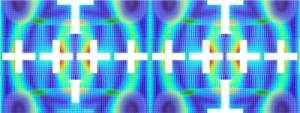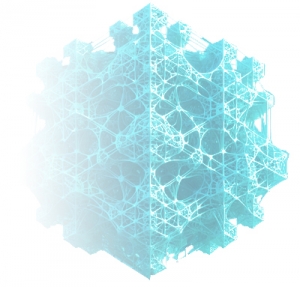The « role of architecture » in (mechanical and acoustic) metamaterials: Mother Nature had already thought of it!
Although no universally accepted definition of metamaterials is currently available in mechanics and acoustics, it is commonly accepted that « geometry » plays a fundamental role in determining their static and dynamic behavior. While in the early 2000s, the shape of the metamaterial unit cells was rather canonical (matrix with circular or square inclusions, etc.), over time, increasingly complex geometries have been explored thanks to the improved calculation power of computers and the evolution of manufacturing technologies.
In this context, Nature, thanks to millions of years of evolution, is a great master of « material architecture » to obtain specific advanced properties and geometries focused on precise functionalities. Taking inspiration from hierarchical or fractal architectures, typical of most biological systems, we show that reproducing this structural enrichment at the mesoscale of metamaterials induces behaviors of great richness, opening new perspectives for elastic wave control based on the simultaneous activation of various wave attenuation mechanisms.
Metamaterials (mechanical and acoustic) and the concept of unit cell architecture
 Although no universally accepted definition of metamaterials is currently available in mechanics and acoustics, the scientific community tends to identify them as « composites with a periodic or quasi-periodic architecture, designed to produce an unconventional (static or dynamic) response to specific solicitations ».
Although no universally accepted definition of metamaterials is currently available in mechanics and acoustics, the scientific community tends to identify them as « composites with a periodic or quasi-periodic architecture, designed to produce an unconventional (static or dynamic) response to specific solicitations ».
The « geometry » therefore plays a fundamental role in determining the properties of metamaterials.
For example, in dynamics, at the same filling fraction(1), the shape (cylindrical, squared, etc.) of the inclusions (or voids) and their distribution in the unit cell (centered, at the edges, etc.) can lead in the dispersion diagram to the opening of frequency bandgaps (frequency regions where the propagation of waves is strongly attenuated) or to curves with negative slope. This allows to attain unconventional behaviors such as negative refraction, topological protection, perfect absorption, etc.
Similarly, when local resonance effects are the main responsible for the overall behavior of the metamaterial, the design of the resonators becomes essential. In this sense, it could be said that metamaterials themselves carry the concept of architecture.
While, in the early 2000s, the geometries explored for the unit cells were rather canonical (matrix with circular or square holes, plates with pillars, etc.), increasingly complex architectures have since been explored. This has been made possible by (i) the increasing calculation power of computers, and (ii) the evolution of manufacturing technologies. Two important examples are 3D printing, producing complex designs at reasonable prices, and (photo-)lithography, which offers unprecedented resolution over several length scales.
(1) Ratio of the volumes making up the matrix and the inclusion in a unit cell.
 This paved the way for a new vision of the concept of « architecture » associated with metamaterials, i.e. « introducing, between the microstructure scale of the constituent material and that of the macrostructure, one or more other scales of organization of matter ». The hierarchical or fractal structures found in most biological systems, where the same geometry can be repeated in a « self-similar » or « non-self-similar » way on several scales, are clear examples. These so-called mesoscopic scales can be weakly separated (coupled) from the macroscopic scale, and induce a wealth of effective behaviors.
This paved the way for a new vision of the concept of « architecture » associated with metamaterials, i.e. « introducing, between the microstructure scale of the constituent material and that of the macrostructure, one or more other scales of organization of matter ». The hierarchical or fractal structures found in most biological systems, where the same geometry can be repeated in a « self-similar » or « non-self-similar » way on several scales, are clear examples. These so-called mesoscopic scales can be weakly separated (coupled) from the macroscopic scale, and induce a wealth of effective behaviors.
Bio-inspiration in metamaterials: Nature, the grand master of material architecture
While mankind has only recently begun to exploit complex architectures (mainly due to technological limitations), Nature, thanks to millions of years of evolution, is a great master of « material architecture » to obtain specific advanced properties and geometries focused on precise functionalities. Indeed, the common feature leading to these surprising properties often lies in the hierarchical organization of matter on several scales (an organization often observed in many natural materials such as wood, bone, sponges, etc.). Consequently, increasing attention has been devoted in recent years to the synthesis of artificial materials inspired by Nature, but primarily targeting quasi-static performance. In contrast, the consideration of hierarchical organization in the elementary cell design of phononic crystals and (mechanical and acoustic) metamaterials[1] is only very recent.
In this context, we presented a new type of metamaterial consisting of a polymer matrix with « non-self-similar » cross-shaped holes repeated at several scale levels. This enabled us to achieve highly attenuative behavior with respect to elastic waves on several frequency scales, thanks to the fact that the « non-self-similar hierarchy » leads to the opening of multiple (and wide) frequency bandgaps, even in the sub-wavelength regime (i.e., when the wavelength of the wave to be attenuated is much greater than the size of the structure itself).
(2) Material architecture is understood here as « the organization of a unit cell repeated on several levels of scale ».
Through numerical models and scanning laser Doppler vibrometer measurements, we have revealed that the « non-self-similar » hierarchy allows the opening of such forbidden bands thanks to the simultaneous activation of multiple attenuation mechanisms: Bragg scattering, local resonance and/or inertial amplification. These mechanisms have been clearly identified by analyzing the imaginary part of the wavenumber. The multi-mechanism design approach leads to enriched dynamics at different scales (opening of additional bandgaps, conservation of the existing frequency-shifted bandgaps, as well as the possibility of preserving the global deformation mechanisms of previous hierarchical levels, despite variations in the mass/rigidity ratio of the overall system).
In conclusion, the enrichment of the architecture of metamaterials at the mesoscale induces effective behaviors of great richness, offering new perspectives for the control of elastic waves, favoring the simultaneous activation of various wave attenuation mechanisms.
References
[1] Mazzotti, […], Miniaci. Bio-inspired non-self-similar hierarchical elastic metamaterials. International Journal of Mechanical Sciences 241:107915 (2023).
[2] Miniaci et al. Bio-inspired hierarchical dissipative metamaterials, Physical Review Applied, 10, 024012 (2018).















